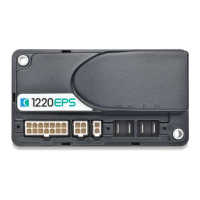Curtis 1220 Manual, Rev. C
31
5 — COMMISSIONING
2
Command Map setup (see page 13)
e fourteen parameters in the Command Map menu dene an 8-point map,
as described on page 13. e input to the Command Map (in units of %) can
be observed in Monitor » Command Input » Steer Command. e output to the
Command Map (in units of degrees) can be observed in Monitor » Command
Input » Target Position (deg).
e Left Stop (deg) parameter is paired with a value of -100%, and the Right
Stop (deg) parameter is paired with a value of 100%. e P1-P6 Output values
ll in the continuum between the two stops; these values should get positive
when center is crossed. Similarly, the P1-P6 Input parameters should start with
negative percent values and increase to positive percent values. e settings of
the point pairs can be customized to shape the map according to the needs of
the application. In general, starting with a linear command map without any
deadband is recommended for vehicles that have the steered wheel in the center.
Setting the Left Stop (deg) and Right Stop (deg) to the correct angle is critical
to the setup of the vehicle as these two parameters set the maximum steering
angle. ey must be set before continuing on to set up the position feedback.
Although any map shape can be set up, it is recommended that the map
always be set so that a Steer Command of zero equals a Target Position (deg) of zero.
3
Command Input Device setup (see page 11)
Your steering command input device will be a dual potentiometer (using pins
J1-6 and J1-13). Most applications will have a primary command input device
and a redundant input device. For applications with only a primary command
input device, you will need to set the Redundant Input Device parameter to O.
Set the Redundant Input parameter to the type of input you will be using:
Redundant Input
0ff = Single input only
0n = Redundant input
+
IMPORTANT

